|
Hellcat Mk.I / Mk.II
Dual Combo
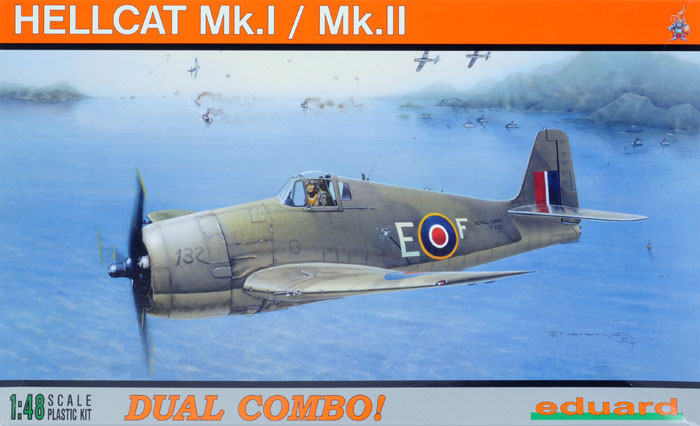
Eduard, 1/48 scale
S
u m m a r y |
| Catalogue Number: |
Eduard Kit No. 8223 - Hellcat Mk.I / Mk.II Dual Combo |
| Scale: |
1/48 |
| Contents and Media: |
240 olive coloured plastic parts; 34 clear parts; 2 x nickel plated photo etched frets;
2 x coloured photo etched fret; masking sheet for
canopy and wheels; large decal sheet covering six markings options |
| Price: |
USD$49.95 plus shipping available online from Eduard's website
and specialist hobby retailers worldwide |
| Review Type: |
FirstLook |
| Advantages: |
Includes two full kits; new complete fuselage and wings for the Hellcat Mk.II (F6F-5); superb detail; excellent surface texture (combination of recessed panel lines, lapped fuselage panels and fabric control surfaces); straightforward parts breakdown; separate control surfaces; ample options including centreline fuel tank, bombs, rockets and four styles of engine cowling; excellent clear parts with different sliding sections for open and closed options; perfect moulding; excellent quality decals. |
| Disadvantages: |
Wheels appropriate only for earliest Hellcats |
| Conclusion: |
Even more detail and even more options than Eduard's recent F6F-3 - great value at a very reasonable price for two full kits. |
Reviewed by
Brett Green

Eduard's 1/48 scale Hellcat Mk.I / Mk.II Dual Combo is available online from Squadron.com
The Grumman F6F Hellcat was designed as a stop-gap upgrade of the lightweight F4F Wildcat, almost as an insurance policy in the event that the F4U Corsair, then under development, did not live up to expectations.
Despite the clear family resemblance to the earlier Wildcat, the Hellcat was an all-new aircraft. The resulting naval fighter was stocky in profile, large, powerfully armed and armoured, and heavy. The Hellcat secured its place in history with a remarkable kill ratio of 19:1.
Being without a robust, high performance naval fighter, the British Fleet Air Arm adopted the Hellcat from the end of 1943. In British service, the F6F-3 was the Hellcat Mk.I, and the F6F-5 was the Hellcat Mk.II.
A total of 1,182 Hellcats of all types eventually saw service with the Royal Navy.
Eduard entered the Hellcat market earlier this year with their F6F-3 Hellcat. This new release covers both major British variants - the Hellat Mk.I and Mk.II - in a "Dual Combo" boxing.
Before we examine the entire contents in detail, let's focus on what is different from the initial release.
The most obvious difference is a new sprue with two styles of rockets. These are suitable for the Hellcat Mk.II, and will probably be included in any subsequent F6F-5 release too. Both sets of rockets are moulded complete with their launching stubs, so you will have a complete set of spares when your Hellcat Mk.II is finished.
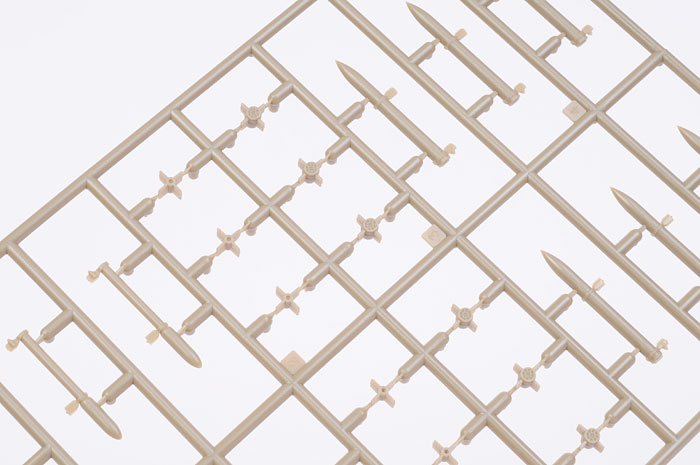
Next is a new fuselage for the Hellcat Mk.II. Eduard continues their policy of "no inserts, no filling panel lines" here. The Hellcat Mk.II fuselage is correctly moulded without the small windows behind the cockpit. Two styles of engine cowl are supplied for the Hellcat Mk.II.
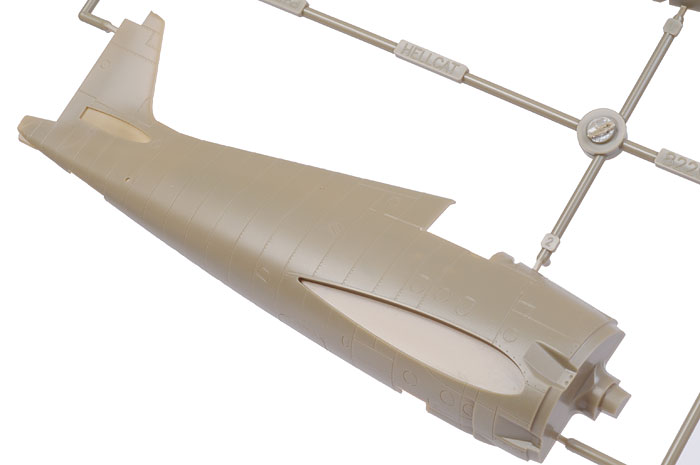
One complete Hellcat Mk.I fuselage - with the windows - is also supplied, so you can build one Mk.I and one Mk.II from this box.
The wings for the Hellcat Mk.II are subtly different too. Some panels have been deleted below the wings. Don't get these mixed up!
The final difference is the photo-etch. Even more detail has been supplied with this kit. Most of the extra coloured parts go into the cockpit - specifically the side consoles.
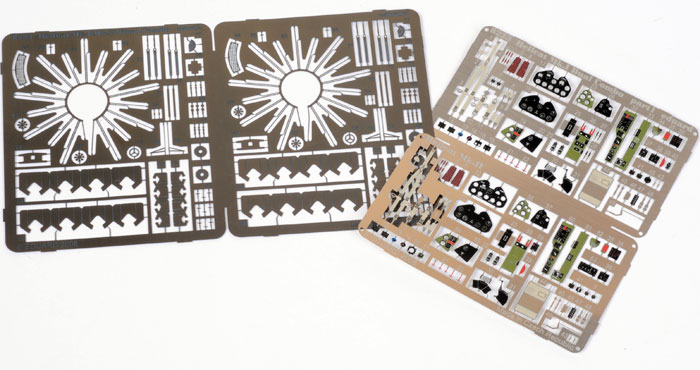
Different instrument panels are supplied for the Mk.I and Mk.II, as well as subtle sidewall and switch details.
Markings
Six marking options are included on the large decal sheet:
-
Hellcat Mk.I JV132, Lt. Blythe Ritchie, 800 Sqn FAA, HMS Emperor, May 8, 1944 finished in US equivalents to Dark Slate Grey and Extra Dark Sea Grey with Sky lower surfaces.
-
Hellcat Mk.I JV131, 800 Sqn FAA, HMS Emperor, June, 1944 finished in US equivalents to Dark Slate Grey and Extra Dark Sea Grey with Sky lower surfaces, with invasion stripes for operations over Normandy.
-
Hellcat Mk.I FN430, 1844 Sqn FAA, P/O Hannay, HMS Indomitable, August 24, 1944 finished in US equivalents to Dark Slate Grey and Extra Dark Sea Grey with Sky lower surfaces and British Pacific Fleet markings
-
Hellcat Mk.II JX814, 1844 Sqn FAA, Sub-Lieutenant W.M.C. Foster, HMS Indomitable, Okinawa, April 12, 1945 finished in US equivalents to Dark Slate Grey and Extra Dark Sea Grey with Sky lower surfaces and large Pacific Fleet markings
-
Hellcat Mk.II JZ796, 808 Sqn FAA, Sub-Lieutenant Oscar Lorenzo, HMS Khedive and HMS Trincomalee, Ceylon, 1945 in overall Gloss Sea Blue
-
Hellcat Mk.II JZ935, 1839 Sqn FAA, HMS Indomitable, Sub-Lieutenant T.B. Speak, April 5th, 1945 in overall Gloss Sea Blue
The decals are opaque, with good colours and perfect register. My experience with Eduard decals has been very positive. They are thin and settle down well into panel lines and contours, responding well to Micro Set and Micro Sol.
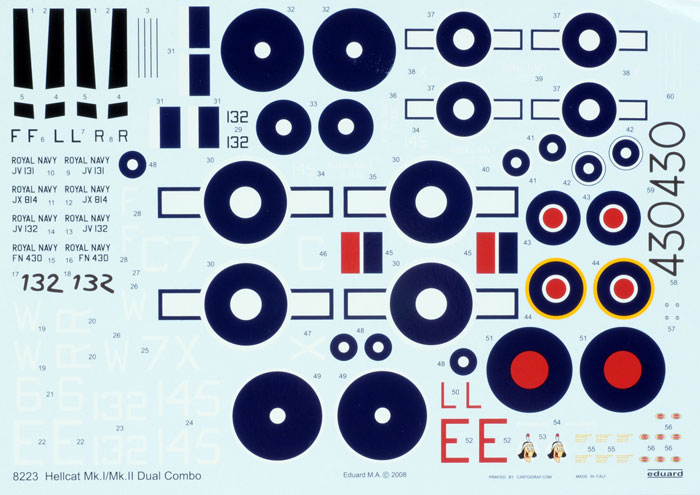
As usual, Eduard has supplied self-adhesive die-cut masks for the canopy and wheels.
Recap
Now that we have covered the main differences, let's recap with details of the entire package:
Eduard's 1/48 scale Hellcat Mk.I / Mk.II Dual Combo comprises 240 olive coloured injection moulded plastic parts; 34 clear parts; 2 x nickel plated photo etched frets; 2 x coloured photo etched frets; masking sheet for canopy and wheels; and a large decal sheet covering six markings options.
Surface texture on Eduard's latest releases has been superb, and these Hellcats enhance that already impressive reputation. In addition to crisp, finely recessed panel lines and selected rows of rivets, the Hellcat fuselage employs a subtle lapped panel effect. This really works well. The fabric ribs on the control surfaces are also very convincing.
Details are equally good. The cockpit is supplemented with the usual compliment of colour photo-etched parts including a layered instrument panel, switch panel and harness straps. For those who prefer to paint their cockpit, an alternative (and very nicely detailed) injection moulded instrument panel is also supplied.
Each engine is a simple assembly with only five plastic parts, but detail is barely compromised. Pushrods are moulded in place, a photo-etched ignition harness is included, plus several colour photo-etched parts for the crank case.
The undercarriage legs and wheel wells are suitably busy. The wheels are supplied with separate hubs and tyres. These appear to be the plain narrow style fitted to the prototypes and the earliest production models, and should be appropriate for the earliest Hellcats. If you are building a later Hellcat Mk.I or any Mk.II, there are after market Hellcat wheels readily available from Ultracast and True Details.
The main gear legs are the appropriate height for an unloaded aircraft. If your model is loaded with bombs and rockets, you might like to shorten the legs by a few millimetres.
The delicate antenna post on the fin is a separate part that may be installed following construction and painting. This is a thoughtful touch that will avoid the almost inevitable damage to a post moulded in place on the top of the fin.
The canopy parts are crystal clear and thin. Separate parts are supplied to permit the sliding canopy to be displayed open or closed.
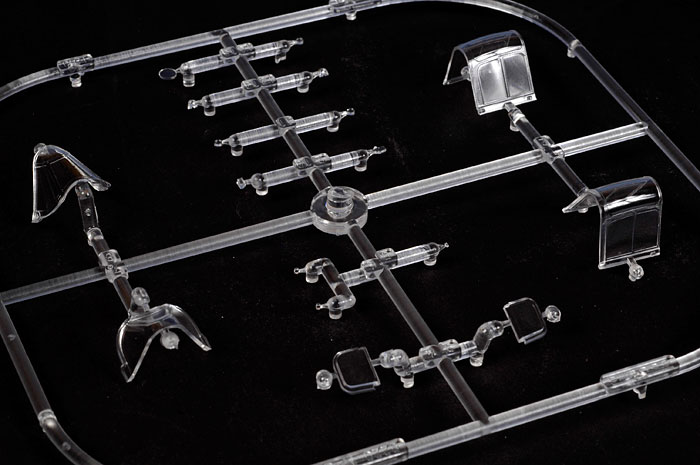
Control surfaces are all supplied separately. These are tabbed to assist precise alignment in the neutral position. It appears that the ailerons and elevators may easily be repositioned after slicing the tabs off.
The cowl is broken down into three pieces, and four different cowl styles are offered.
Eduard's 1/48 scale Hellcat is beautifully detailed, features excellent surface texture and offers plenty of useful options to the modeller.
Whereas Eduard's last two new-tool offerings, the Fw 190 and Bf 110 families, have been challenging to build in some respects, this new Hellcat is noticeably more straightforward. Eduard has responded to comments about kit complexity with a model that is quite simply broken down without compromising detail in important areas such as the engine face, cockpit and undercarriage. Building the Eduard Hellcat should present no hurdles to the average modeller.
With even more detail than their debut F6F-3 release, plus more options with the new rocket sprue, and a price tag only $15.00 higher than the original single kit, this dual-Hellcat boxing represents great value too!
Thanks to Eduard for the sample
Review Text and Images Copyright © 2008 by Brett Green
Page Created 17 July, 2008
Last updated
17 July, 2008
Back to HyperScale Main Page
Back to Reviews Page |
